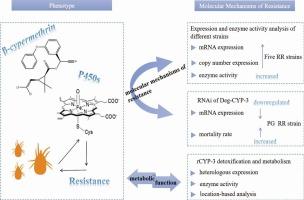Deg-CYP-3调控鸡皮蝇对高效氯氰菊酯抗性的功能分析
IF 4
1区 农林科学
Q2 BIOCHEMISTRY & MOLECULAR BIOLOGY
引用次数: 0
摘要
鸡皮虫是蛋鸡重要的食血体外寄生虫。尽管高效氯氰菊酯在世界范围内广泛应用于螨虫防治,但鸡瘿螨已对该化合物产生抗药性。P450s作为参与外源和内源化学物质代谢的关键解毒酶,在鸡鸡中尚未得到功能表征。本研究研究了鸡粉虱P450s基因(Deg-CYP-3)在杀螨抗性中的作用。首先,5个高效氯氰菊酯抗性品系(RR)对对硝基苯甲醚的p450酶活性显著高于敏感品系(RS),表明酶活性的增强可能是造成螨对高效氯氰菊酯抗性的原因之一。除DK株外,RR株中Deg-CYP-3 mRNA表达量和DNA拷贝数均显著高于RS。此外,在大肠杆菌中表达的重组Deg-CYP-3 (rCYP-3)对对硝基苯甲醚具有较高的酶活性,而Qulaton-100、丙酮、异丙酮、阿维菌素和伊维菌素对该酶活性有抑制作用。免疫组化分析显示消化道和马氏小管中存在Deg-CYP-3蛋白。最后,通过RNAi沉默Deg-CYP-3导致PG RR菌株酶活性降低,对高效氯氰菊酯的敏感性增加,证实Deg-CYP-3对高效氯氰菊酯解毒至关重要。RNAi还导致PG RR菌株的死亡率增加,以及产卵和繁殖力降低。综上所述,这些发现表明鸡鸡对高效氯氰菊酯的抗性与p4500s蛋白活性升高和Deg-CYP-3表达水平升高有关。研究结果为深入了解鸡瘿螨代谢抗性机制提供了依据,为螨的防治提供了科学指导。本文章由计算机程序翻译,如有差异,请以英文原文为准。

Functional analysis of the regulation of beta-cypermethrin resistance by Deg-CYP-3 in Dermanyssus gallinae
Dermanyssus gallinae is a significant haematophagous ectoparasite of laying hens. Despite the worldwide application of beta-cypermethrin for mite control, resistance to this compound has been developed by D. gallinae. P450s, as key detoxification enzymes involved in the metabolism of exogenous and endogenous chemical substances, have not been functionally characterized in D. gallinae. Here, the role of the P450s gene (Deg-CYP-3) of D. gallinae in acaricide resistance was studied. Firstly, P450s activities of the five beta-cypermethrin resistant strains (RR) against p-nitroanisole were significantly higher than that of the susceptible strain (RS), suggesting enhanced enzymatic activities might contribute to mite beta-cypermethrin resistance. Both mRNA expression level and DNA copy number of Deg-CYP-3 were significantly higher in RR than in RS, except for DK RR strain. Moreover, recombinant Deg-CYP-3 (rCYP-3) expressed in Escherichia coli displayed high enzymatic activity against p-nitroanisole, while Qulaton-100, acetone, isoacetone, avermectin, and ivermectin were found to inhibit this activity. Immunohistochemical analysis revealed the presence of Deg-CYP-3 protein in the digestive tract and Malpighian tubules. Finally, silencing of Deg-CYP-3 via RNAi resulted in decreased enzyme activity and increased susceptibility of PG RR strain to beta-cypermethrin, confirming that Deg-CYP-3 is crucial for beta-cypermethrin detoxification. RNAi also resulted in enhanced mortality, as well as reduced oviposition and fecundity in the PG RR strain. Collectively, these findings indicate that resistance of D. gallinae to beta-cypermethrin is associated with elevated P450s protein activity and increased Deg-CYP-3 expression levels. The results provide insights into the metabolic resistance mechanisms of D. gallinae and offer scientific guidance for the management and control of mite.
求助全文
通过发布文献求助,成功后即可免费获取论文全文。
去求助
来源期刊
CiteScore
7.00
自引率
8.50%
发文量
238
审稿时长
4.2 months
期刊介绍:
Pesticide Biochemistry and Physiology publishes original scientific articles pertaining to the mode of action of plant protection agents such as insecticides, fungicides, herbicides, and similar compounds, including nonlethal pest control agents, biosynthesis of pheromones, hormones, and plant resistance agents. Manuscripts may include a biochemical, physiological, or molecular study for an understanding of comparative toxicology or selective toxicity of both target and nontarget organisms. Particular interest will be given to studies on the molecular biology of pest control, toxicology, and pesticide resistance.
Research Areas Emphasized Include the Biochemistry and Physiology of:
• Comparative toxicity
• Mode of action
• Pathophysiology
• Plant growth regulators
• Resistance
• Other effects of pesticides on both parasites and hosts.

 求助内容:
求助内容: 应助结果提醒方式:
应助结果提醒方式:


